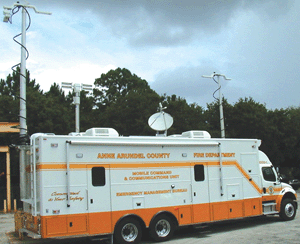Tech success: Mobile unit eases communications in Big Easy

When first responders began arriving in New Orleans after Hurricane Katrina, one of the biggest coordination problems they faced was communicating with one another.
When first responders began arriving in New Orleans after Hurricane Katrina, one of the biggest coordination problems they faced was communicating with one another.Fire departments, police, National Guard units and others use several different radio systems that cannot interoperate, including 800-MHz digital, high-band UHF and aviation bands.To help remedy the problem Anne Arundel County, Md., sent its new mobile command and communication unit to the Gulf Coast. The 45-foot truck is a mobile dispatch center that can work with 17 different radio types."When we got in the field in New Orleans and explained what we were capable of doing, we had to tell them twice, because they didn't believe it," said Steve Morgan, senior program manager with Arinc Inc., the Annapolis, Md., company that designed the unit and integrated the technology.It was the communications problems caused by Tropical Storm Isabel in 2003 that impressed upon Anne Arundel County officials how important radio interoperability is when various agencies respond to an incident, said Matt Diehl, county spokesman. Local, state and federal agencies reacted to the flooding Isabel caused but couldn't talk with each other."When you have so many different agencies of government dealing with one particular situation, the communications tend to break down, because everybody has their own radios and communications systems," Diehl said. "A resource like this mobile command unit would have helped in that situation."Achieving interoperability during any incident was the main goal in buying the mobile command unit. County officials used a state-administered homeland security grant for the unit, Diehl said.The Maryland county has not yet needed the mobile command and communication unit for an incident, but during a crisis, it would most likely be used as a secondary operations center."A lot of times, when you're managing an emergency operation, you need to have first-hand information," Morgan said. "A command center like this out in the field really helps."In addition to its ability to handle different radio types, the command unit has IP telephony capabilities, videoconferencing and video surveillance. It also has multiple ways to establish an Internet connection, including WiFi and satellite.Without this technology, an incident commander responding to a crisis first would need at hand representatives from all involved agencies. Orders going to people in the field would have to be repeated several times over the different radio systems. The only other way to deal with the lack of interoperability is to hand out the same radios to all public safety personnel aiding an event, Morgan said.Using Arinc's Wireless Interoperable Network Solutions technology, the dispatcher can communicate with anyone in the field and create a conference, so first responders can talk to each other, even if they have different types of radios.The mission in New Orleans was to coordinate sending emergency medical technicians to makeshift clinics sited throughout the area. Dispatchers monitored the radio traffic and kept tabs on all EMTs.An EMT needing security would call in using the 800-MHz radio. Dispatchers would use VHF low-band radios to notify National Guard troops, and keep clinics up to date via their VHF high-band radios, Morgan said."We could activate a conference that would put all three of them in one large talk group," he said. "The EMT could talk directly to situation managers as well as the National Guard security patrol, while they were all on different radio systems."Tying it together are standards-based components based on Cisco technology, said Chris Boyd, a Cisco Systems Inc. homeland security consulting engineer. A land mobile radio gateway adapts radios in the field to IP."The idea is to neutralize the path to allow any to any communication, where IP is the underlying glue," Boyd said. "Because it is IP-based, it can run over any IP-capable underlying technology. In a tactical environment, you want as many ways to communicate as possible and bring them all with you. So there are multiple ways this vehicle can connect."In New Orleans, the satellite connection proved most reliable, Morgan said. If the infrastructure is in place, the truck also can establish a long-range 802.11 5.8-GHz WiFi connection.The mobile unit uses Cisco's Call Manager Express, a router-based call manager. The Cisco 7900 series phones also are used to allow voice communication in the truck and to the outside. As many as 14 people can work in the truck simultaneously.The software resides on four Windows servers."Each rack has different parts of the system installed on it, and it's distributed for redundancy," Morgan said. "We have two of everything, and they're on different racks with different power sources."Getting the truck operational takes only as long as it takes to boot up the servers."We were able to get our mission up and operational within 24 hours of being on ground in New Orleans," Morgan said. "One of the head guys at the National Guard, as well as those managing the incident, really were just astonished at the ability to put this all together so quickly. It's something they had never seen in the field before."If you have an innovative solution that you recently installed in a government agency, contact Staff Writer Doug Beizer at dbeizer@postnewsweektech.com.


The county's Mobile Command and Control Unit sets up for a systems test at Arinc's Annapolis, Md., headquarters.
Arinc Inc., Cisco Systems Inc.
NEXT STORY: Small business makes big news